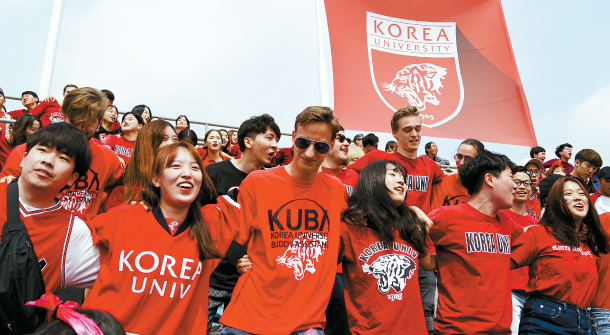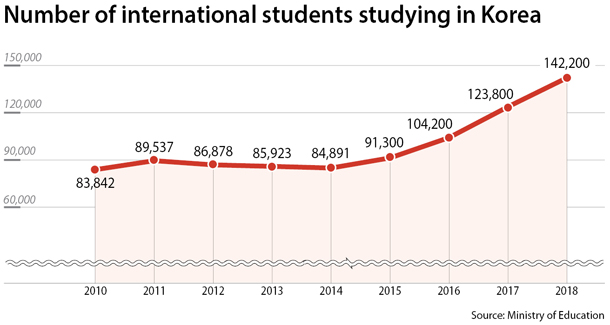Korean schools look abroad for revenue, prestige

Korea University international students practice the school’s cheers alongside Korean students in preparation for the field day against Yonsei University in September 2017. [KOREA UNIVERSITY]
At least one out of 10 students who pass by is a foreigner. Off to one side, a crowd of international students are gathered around a bench chatting. These days, foreign students are a common sight at many Korean universities.
Korea University has the largest international student body in the country. A total of 4,800 foreign undergraduate, graduate and exchange students from 120 different countries are enrolled in Korea University. The university’s foreign student population increased by 1,800 from the around 3,000 students who were enrolled four to five years ago.
Even then, the number was still high enough to put Korea University in third-place among international students in Korea after Yonsei University and Kyung Hee University. Due to Korea University’s active recruitment of international students, over 10 percent of the undergraduate student body today is made up of international students.
The total number of international students studying in Korea has rapidly increased in the past three to four years. From 2010 to 2014, the number of international students studying in Korea was in the 80,000 range. That number, however, started to rise in 2015. According to statistics released by the Education Ministry, 91,300 international students studied in Korea in 2015. In 2016, that number jumped to 104,200, and in 2017, it once again increased to 123,800. A total of 142,200 international students are currently studying in Korea. In the past four years, the number of students has increased by 67.5 percent from 2014.
According to Unesco, as of 2016, the United States has the largest international student population with 970,000 students in undergraduate or graduate programs in universities across the nation. Britain is second with 430,000 international students, followed by Australia (330,000), France (240,000) and Germany (240,000). Japan was ranked eighth in total with 143,000 international students studying in their universities, the most in Asia, followed by China (137,000).
Korea was ranked 18th. However, the rankings shift drastically once the nations are ranked according to per capita. In Korea, there are 120.4 international students per 100,000 people. This puts Korea ahead of Japan which only has 113.5 international students per 100,000 residents. In comparison to the previous year’s statistics, Korea saw a 13.5 percent increase in international students, whereas those in Japan increased by 8.7 percent and China increased by 11.7 percent. If this trend continues, it is safe to say that the number of international students in Korea will continue to increase.

Korean universities are keen to attract international students for two reasons. The biggest reason is that attracting more international students, universities can even out their financial deficits. These deficits were originally created because of a lack of domestic enrollment. After reaching its peak in 2010 with over 502,000 Korean students enrolling as freshmen, the numbers started to decrease rapidly. There are now 401,000 domestic students enrolled in Korean universities as of last year, a 20 percent decrease from 2010. Since universities rely on tuition fees to operate, the lack of students is becoming a serious issue. This problem is especially acute at less prestigious private universities outside of Seoul.
Another reason is the common belief that the number of international students attending a university correlates with how prestigious the university is. In additional to various evaluation agencies, the universities themselves use the number of international students as an indication of how internationally-recognized they are. In order to be recognized as a prestigious university, the school administration has to attract international students. This stance is actively encouraged by the government. The Education Ministry, which aims to attract over 200,000 international students by 2023, lowered the standards for Korean language proficiency required for foreign students who wish to study in Korea. Previously, international students were required to achieve at least Level 3 on the Topik (Test of Proficiency in Korean). However, starting from early this year, international students can come to study in Korea with only a Topik Level 2.
As Korean culture and language has been growing in popularity through foreign media and the internet, more international students are coming to study in Korea with each passing year. Many Chinese and Southeast Asian students want to become familiar with the Korean language and culture so they can get a job at Korean companies that have offices in their own countries. For Southeast Asian students in particular, the salary that workers can receive from a Korean company can be as much as three times that of a local company.
Because of this phenomenon, many students from countries that have a large number of Korean business offices often come study abroad in Korea. The number of Vietnamese students studying abroad in Korea has increased notably over the years. This correlates with the fact that many Korean companies have moved their facilities from China to Vietnam because of sharp wage increases in China. Currently, more than 6,000 Korean companies do business in Vietnam, and they account for 35 percent of the country’s exports. According to the statistics issued by the Education Ministry, in comparison to 2012, when only 3,200 Vietnam students were studying in Korea, this number has increased to 27,500 as of last year.
With the sharp increase in foreign students in Korea, each university is paying particular attention to managing their foreign student population. Korea University opened a new Global Service Center last year. This center provides various services for international students help them adjust to life in Korea. The university also runs a foreign student mentor program that pairs international students with Korean students.
In addition, various events like sporting events, parties and international festivals are organized so international students can participate and better assimilate into the student body.
“We have even built prayer rooms in dorms and in the College of Engineering where Malaysian students can practice their Islamic beliefs,” said Kim Jong-geun, the director of Korea University’s Global Service Center.
Of private universities located outside of Seoul, Sun Moon University has the largest international student body population, with 1,500 currently enrolled as of this year. The university, which is located in Asan, South Chungcheong, has a unique housing system that requires international students to live alongside domestic students. In Sun Moon Dormitory Hall, which can hold up to 520 students, half of the occupants are international students.
“This way, international students can more easily adapt to life in Korea,” said Shin Nyung-muk the director of Global Affairs. Sun Moon University hosts Korean speaking contests and songpyeon (sweet rice cake) making competitions annually to help international students better adapt to Korean culture.
“[Sun Moon University] has created a “global vice president position” that is in charge of attracting new international students and managing the ones that are already attending our school,” said Lim Hyung-taek, director of the Office of International Affairs in Sun Moon University.
The increase in international students benefits domestic students as well. Domestic students can learn about different cultures and language through interacting with their international counterparts.
At Korea University, international students from South America often volunteer to help out in Spanish classes.
A number of problems, however, have arisen due to the rapid increase in foreign students. The most serious issue is that some foreigners with no intention of studying in Korea have been admitted into the country under a student visa.
Instead of studying, these foreigners often work to earn money. After overstaying their visas, they become undocumented. Some Chinese and Vietnamese students who enter with student visas collectively disappear from local language institutes.
According to a governmental survey, 11,100 foreign students are currently overstaying their visas. That number has increased by 98 percent in the last three years. In addition, companies in Vietnam have set up offices devoted to disguising workers as students and sneaking them into Korea.
The lack of Korean language proficiency for most international students is also a problem that needs to be resolved. International students can come to study in Korea with only a Level 2 on the Topik. The consensus is that international students need at least a Level 5 in Topik to understand and follow class material, however. This is why Korea University requires students to study in a Korean language school for at least one year before they join regular Korean classes. However, many universities do not take lack of Korean language proficiency into serious consideration.
Conflicts with domestic students often arise because of language barriers, as well. Many domestic students have testified that they avoid teaming up with international students on projects because the international students can’t help with writing project reports in Korean.
Korean universities also haven’t figured out what to do with students who excel in their studies.
Some international students do much better academically than domestic students. In particular, foreigners who come to Korea through government-sponsored scholarships often excel academically. This year, the top student in the media studies major in Korea University was from China and the valedictorian in the College of Social Studies in Sookmyung Women’s University was from Kenya.
Nevertheless, not many of these top talents get jobs with Korean companies, as many companies still prefer to hire Korean nationals rather than foreigners.
Unless this recruitment problem is improved, talented foreign graduates who came to Korea expecting to achieve their Korean dream will be forced to go back to their nation with nothing in return. Experts believe that, if this continues, international students who studied here will discourage others from following in their footsteps.
BY NAM JEONG-HO [jeong.juwon@joongang.co.kr]










with the Korea JoongAng Daily
To write comments, please log in to one of the accounts.
Standards Board Policy (0/250자)